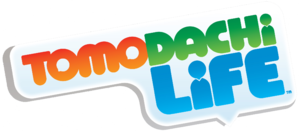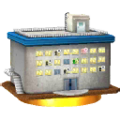Tomodachi (universe): Difference between revisions
m (Text replacement - "{{DISPLAYTITLE:" to "{{Title|") |
No edit summary |
||
| Line 59: | Line 59: | ||
====Returning Tracks==== | ====Returning Tracks==== | ||
*{{gameIcon|SSB4}}'''{{SSBUMusicLink|Other|Afternoon on the Island (for 3DS / Wii U)}}''': A slower paced arrangement of daytime themes from ''Tomodachi Collection'' and ''Tomodachi Life''. Returns from ''Smash 4''. | *{{gameIcon|SSB4}}'''{{SSBUMusicLink|Other|Afternoon on the Island (for 3DS / Wii U)}}''': A slower paced arrangement of daytime themes from ''Tomodachi Collection'' and ''Tomodachi Life''. Returns from ''Smash 4''. | ||
==Games with elements appearing in the ''Super Smash Bros.'' series== | |||
===''{{s|wikipedia|Tomodachi Collection}}''=== | |||
*Music: | |||
**{{gameIcon|SSB4}} '''{{SSBUMusicLink|Other|Afternoon on the Island (for 3DS / Wii U)|Tomodachi Life}}''': This remix contains the daytime theme of this game. | |||
**{{gameIcon|SSBU}} '''{{SSBUMusicLink|Other|Afternoon on the Island}}''': This remix contains the daytime theme of this game. | |||
===''{{s|wikipedia|Tomodachi Life}}''=== | |||
*Stages: | |||
**{{gameIcon|SSB4-3DS}} [[Tomodachi Life]] appears as a stage. | |||
*Trophies: | |||
**{{gameIcon|SSB4-3DS}} Mii Apartments and Golden appear as trophies. | |||
*Music: | |||
**{{gameIcon|SSB4}} '''{{SSBUMusicLink|Other|Afternoon on the Island (for 3DS / Wii U)|Tomodachi Life}}''': This remix contains the daytime theme of this game. | |||
**{{gameIcon|SSBU}} '''{{SSBUMusicLink|Other|Afternoon on the Island}}''': This remix contains the daytime theme of this game. | |||
==Trivia== | ==Trivia== | ||
Revision as of 17:27, February 26, 2023
| Tomodachi (universe) | |
|---|---|
 
| |
| Developer(s) | Nintendo |
| Publisher(s) | Nintendo |
| Genre(s) | Life Simulation |
| Console/platform of origin | Nintendo DS |
| First installment | Tomodachi Collection (2009) |
| Latest installment | Miitomo (2016) |
The Tomodachi universe (トモダチコレクション, Tomodachi Collection) refers to the Super Smash Bros. series' collection of properties that carry the Tomodachi branding.
Franchise Description
The franchise was initially made as a response to the lack of Mii representation on the Nintendo DS, as it was released two years before their official debut. A relatively young team led by Yoshio Sakamoto was brought together in 2006 to brainstorm how to implement Miis into a game. They eventually settled on a life simulation game, taking particular inspiration from the 2000 Game Boy Color game Tottoko Hamtaro: Tomodachi Daisakusen Dechu. Sakamoto has said that he wanted his game to be "A version of that game that adult woman can play." The working title for the game was even 大人のオンナの占い手帳. They came up with the idea of a character creation tool based on Fukuwarai, which inspired to Wii developers to create Mii Maker[1]. These efforts culminated in 2009 with the release of Tomodachi Collection. In this game, players needed to feed, clothe, and watch over the more-than-often ridiculous lives of their Mii characters, as they go about and perform daily activities, make friendships, and start romantic relationships (to the point of marriage and starting a family). While the game was a success, it never officially released outside of Japan.
A sequel was released in 2013 for Nintendo 3DS, titled Tomodachi Life (titled Tomodachi Collection: New Life in Japan). This game would receive an international release in 2014. The game is similar to its predecessor in terms of gameplay and presentation, just with more options and possible events. The game was a great success and helped propell the Mii brand out of a decline in popularity at the time.
Next came a spiritual successor for IOS and Androind titled Miitomo. While not carrying the official Tomodachi branding, it has all the basic gameplay mechanics of the series while retooling them into an online focused social network setting. It was the first ever first-party Nintendo game to officially release on mobile devices. While initially very popular at launch, engagement quickly fell due to lack of interest and the service was discontinued in 2018.
In Super Smash Bros. for Nintendo 3DS
The series is represented by a single stage, its music track, and two trophies in Super Smash Bros. for Nintendo 3DS.
Stage
- Tomodachi Life (Starter): A stage set in the Mii Apartments. The front walls of the apartments disappear so the area within is visible when a fighter overlaps with the room. The rooms are randomly placed and selected from among several types. Occasionally, the player will encounter a Mii character in the apartment pulled straight from their 3DS's Mii Plaza.
Music
Original Track
- Tomodachi Life: An arrangement of the daytime theme from Tomodachi Life and the daytime theme from Tomodachi Collection, which plays on the Tomodachi Life stage.
Trophies
In Super Smash Bros. for Wii U
Music
Original Track
- Tomodachi Life: An arrangement of the daytime theme from Tomodachi Life and the daytime theme from Tomodachi Collection, which plays on the Miiverse stage.
In Super Smash Bros. Ultimate
Stage
 Tomodachi Life (Starter): returns as a retro stage.
Tomodachi Life (Starter): returns as a retro stage.
Music
Original Track
- Afternoon on the Island: An arrangement of daytime themes from Tomodachi Collection and Tomodachi Life.
Returning Tracks
 Afternoon on the Island (for 3DS / Wii U): A slower paced arrangement of daytime themes from Tomodachi Collection and Tomodachi Life. Returns from Smash 4.
Afternoon on the Island (for 3DS / Wii U): A slower paced arrangement of daytime themes from Tomodachi Collection and Tomodachi Life. Returns from Smash 4.
Games with elements appearing in the Super Smash Bros. series
Tomodachi Collection
- Music:
 Tomodachi Life: This remix contains the daytime theme of this game.
Tomodachi Life: This remix contains the daytime theme of this game. Afternoon on the Island: This remix contains the daytime theme of this game.
Afternoon on the Island: This remix contains the daytime theme of this game.
Tomodachi Life
- Stages:
 Tomodachi Life appears as a stage.
Tomodachi Life appears as a stage.
- Trophies:
- Music:
 Tomodachi Life: This remix contains the daytime theme of this game.
Tomodachi Life: This remix contains the daytime theme of this game. Afternoon on the Island: This remix contains the daytime theme of this game.
Afternoon on the Island: This remix contains the daytime theme of this game.
Trivia
- The series symbol for the Tomodachi universe seems to be loosely based on the house a couple owns after marriage, albeit with a slightly altered window.
- The R.O.B. treasure's description in Tomodachi Life references his playability in Super Smash Bros. Brawl.
References
|
| |
|---|---|
| Stage | Tomodachi Life |

